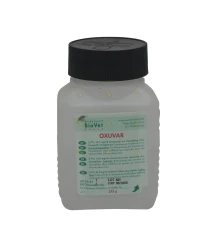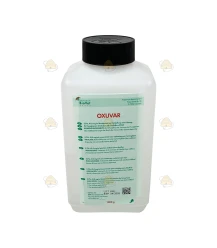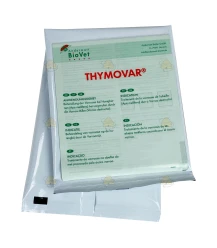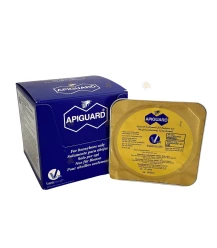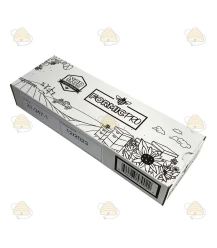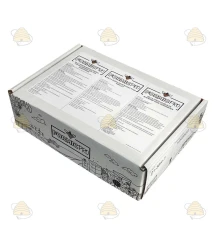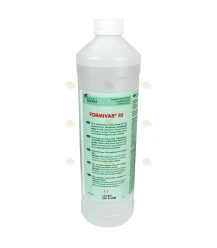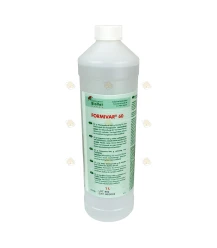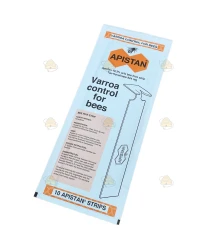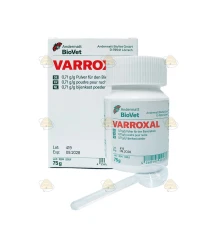Varroa control
Every beekeeper has to deal with it. Varroa in the hive. Controlling varroa can be done in many ways. For example, by using the new oxalic acid vaporizer; 'the Varrofix'. But there are many other possibilities. On this page you will find resources for the control of varroa mites.
-
VarroMed 555 ml by Beevital (REG NL 129149)
€ 28,85 Product available with different optionsProduct available with different optionsVarroMed by BeeVital is a treatment to control Varroa mites. It replaces HiveClean. VarroMed can be applied in all seasons. Organic beekeepers can use VarroMed without any problem. The active substances are oxalic acid and formic acid. Do not use during the nectar flow, but it can be applied before and after. The withdrawal period is 0 days; this means...View more -
Oxuvar 5.7% 275 g for 10-15 bee colonies (REG NL 116565)
€ 15,45 In stock and available for immediate delivery.Oxuvar is a ready-made oxalic acid solution. This makes it easy to prepare your own trickle or spray solution. For the oxalic acid trickle method, adding 275 g sugar is sufficient. Shake briefly until the sugar has dissolved. You can then trickle using a [product id=1161]dosing syringe[/product]. Trickle about 5 ml per seam of bees. Oxuvar can also be...View more -
Oxuvar 5.7% 1000 g (REG NL 116565)
€ 29,85 Product available with different optionsProduct available with different optionsOxuvar is a pre-dissolved oxalic acid (ethanedioic acid) solution. This makes it easy to prepare your own trickle or spray solution. Warm the liquid in a water bath to 30-35 degrees. For the oxalic acid trickle method, adding 1000 grams of sugar is sufficient. Shake briefly until the sugar has dissolved, then trickle using a [product id=1161]dosing...View more -
Thymovar for Varroa control (REG NL 10330)
€ 26,95 In stock and available for immediate delivery.Thymovar is a treatment from Andermatt BioVet for the Varroa mite. It works by means of volatile substances that evaporate in the hive, which the Varroa mite cannot tolerate. Each pack contains 2 x 5 strips. Use 1 strip per brood box (brood chamber). For a Dadant hive you can use 1.5 strips per brood box (brood chamber). Suitable for use after the last...View more -
Apiguard thymol-based 2-pack (REG NL 10038)
€ 7,99 In stock and available for immediate delivery.Unfortunately, we cannot offer this product in Belgium. Belgian national legislation does not allow us to sell these products online. They may only be sold in pharmacies. Apiguard is based on thymol, just like Thymovar. Apiguard is a gel that slowly releases thymol vapours. Varroa mites cannot tolerate these. Pack of 2 for 1 hive. Its mode of action is...View more -
FormicPro 2 x 2 strips (REG NL 126198)
€ 27,95 Out of stockOut of stockFormic Pro (2 x 2 strips) for the treatment of varroosis caused by the Varroa mite. This product from Andermatt BioVet is very easy to use and quick to apply in your colony. The only steps you need to take as a beekeeper are unpack, place, and you’re done. You can place the strips directly on top of the hive frames (wear gloves). Formic Pro penetrates...View more -
FormicPro 10 x 2 strips (REG NL 126198)
€ 91,95 Out of stockOut of stockFormic Pro (10 x 2 strips) for the treatment of varroa mite infestations. This product from Andermatt BioVet is very easy to use and can be applied quickly in your colony. The only steps you need to take as a beekeeper are: unpack, place, and you’re done. You can place the strips directly on top of the hive frames (wear gloves). Formic Pro reaches mites...View more -
Formic acid Formivar 1 liter 85% (REG NL 118711)
€ 17,45 Out of stockOut of stockPlease note: Unfortunately, Formivar is not approved for use in Belgium. We therefore cannot ship it to Belgium. Formivar 85% formic acid, 1 liter (registered for sale in the Netherlands). Formic acid is used to treat Varroa mite. Formivar is suitable for severe and very severe Varroa infestations; this corresponds to a natural mite drop of approx. 10...View more -
Formic Acid Formivar 1 liter 60% (REG NL 118709)
€ 13,85 Out of stockOut of stockNote: Unfortunately, Formivar is not approved for use in Belgium. We therefore cannot ship it to Belgium. Formic acid 60% by Formivar per 1 liter (registered for sale in the Netherlands). Formic acid is used in the treatment of Varroa mite. Formivar is suitable for use in severe and very severe Varroa infestation; this corresponds to a natural mite drop...View more -
Apistan varroa strips 10 pcs (REG NL 9309)
€ 27,75 In StockNote: Unfortunately, Apistan is not approved for use in Belgium. We therefore cannot ship it to Belgium. Apistan varroa strips, pack of 10, for easy control of varroa mites. Hang two strips in the brood box for six weeks (two brood cycles) at the end of the season. The strips should hang on two different hive frames, fairly centrally in the brood box...View more -
Varroxal (REG NL 127068)
€ 35,95 Product available with different optionsProduct available with different optionsVarroxal contains oxalic acid dihydrate at a concentration of 0.71 g per g and can be used in powder form, sprayed when dissolved in water, or trickled with sugar syrup. This now gives Dutch beekeepers a legal option to treat their colonies in winter using oxalic acid. Varroxal is available in 75 g packs. The shelf life of Varroxal is 5 years, provided it...View more
Which pesticide is best to use?
Want to varroa control, then today there are many different remedies you can use. We do not give advice on what is the best method for you. Please read the guide of bijen@wur. There are many resources that can be used. These include ApiGuard and Thymovar. There are also other ways that beekeepers use to control the varroa mite. We always recommend a combination of agents to avoid resistance to any of the agents. This also ensures the most effective control of mites. For a effective control, it is necessary to treat the hives against varroa a few times a year. This is usually done once after the honey harvest before the winter bees hatch and once in the winter when the bees have no brood.
Another method recommended by bees@wur and LNV is the treat with formic acid. The main advantage of controlling varroa with formic acid is that it is the only agent that also kills the mites in the brood. Furthermore, formic acid is a natural agent, which is also found in honey. It is also biodegradable.
Another agent commonly used to control varroa is oxalic acid. This is sold, for example, under the name Oxuvar. Treating with oxalic acid provides high control effectiveness because the agent has a high acidity. As a result, when properly treated with oxalic acid, between 90% and 99% of all varroa mites killed. Oxalic acid does not work in closed brood and is therefore best used in hives without closed brood such as a swarm, a hive in a broodless period or a hive that has been deliberately made broodless.
Which vaporizer is best to use?
For treatments with oxalic acid, for example, an evaporator can be used. With this you spread the oxalic acid as vapor in the hive. But it can also be administered as drops in the alleys of the hive. For the best method of treatment, the guide from bees@wur is an excellent reference. To use formic acid, you need to use a vaporizer. The drug can be vaporized in a controlled manner with the vaporizer.
The Liebig evaporator/ Liebig dispenser offers a low-cost and effective solution for varroa control using formic acid. The Liebig vaporizer can be used safely after being filled and can be monitored during vaporization.
The Varrofix verdamper is een betaalbare verdamper en bovendien ook nog eens zeer tijdefficiënt als je maar enkele volkjes hebt. Na anderhalve minuut is de verdamper op de juiste temperatuur. De hele behandeling duurt in totaal maximaal 15 minuten. De mijten gaan binnen 24 uur dood. Nu ook verkrijgbaar als Deluxe set, including battery, charger and timer.
The Sublimox APF-PLUS vaporizer is one of the more luxurious vaporizers in our range. This vaporizer constantly gives off the right temperature during treatment. The Sublimox is connected to 230V and is easy to operate. The Sublimox vaporizer is CE certified and is delivered as a complete set, including heating element with handle and automatic temperature regulation, two lids for administering oxalic acid, a 3 meter long cable and a handy case for transportation.
Also, the Varrox Eddy verdamper is een handige draagbare verdamper, die geschikt is voor vrijwel elke gangbare maat bijenkast. De verdamper dient in de vliegopening van de bijenkast geplaatst te worden en met 1 druk op de knop doet de verdamper daarna vervolgens vanzelf het werk. Ook verkrijgbaar als Deluxe set, including extra battery.
When using an evaporator in a polystyrene/EPS (Styrofoam) hive, always provide a heat-resistant sheet of wood or the like under the evaporator that gets hot.
Other treatment methods
Apiguard is a thymol-based gel that slowly releases thyme vapors. Thymol is not harmful to bees or humans. The gel is packaged in trays. During treatment, the tray should be opened. The tray should then be placed in the middle on the brood frames, with the gel at the top. If space is limited, you can also choose to spoon the gel from the tray onto the windows. After 2 weeks, the tray should be replaced for a new one. The total treatment time is 4 to 6 weeks.
Thymovar works basically the same as Apiguard. Thymovar, unlike Apiguard, consists of strips based on Thymol. These strips can be placed in the hive, to which they release volatile substances that evaporate in the hive. The varroa mites cannot withstand this.
VarroMed is a varroa control method based on oxalic acid and formic acid. It should not be used during honey pregnancy, but can be used before and after. The withdrawal period is 0 days. This means that after treatment, the honey chamber can be placed right away.



